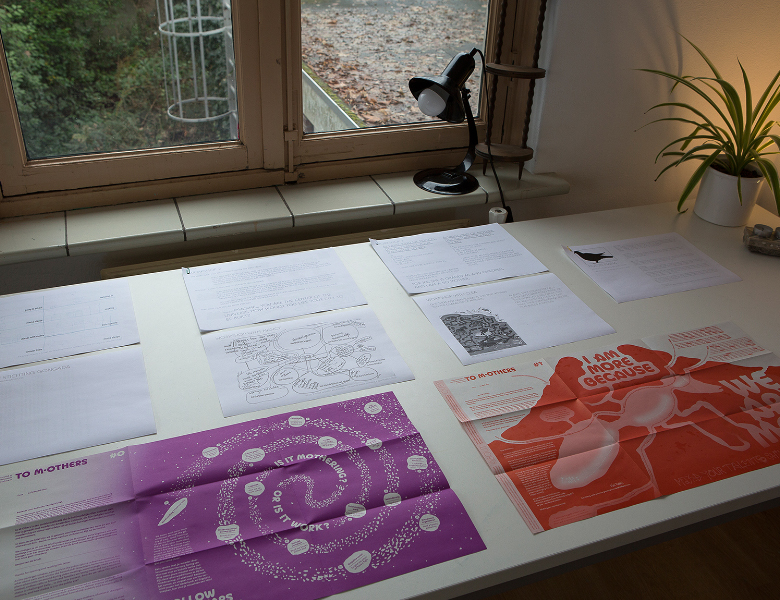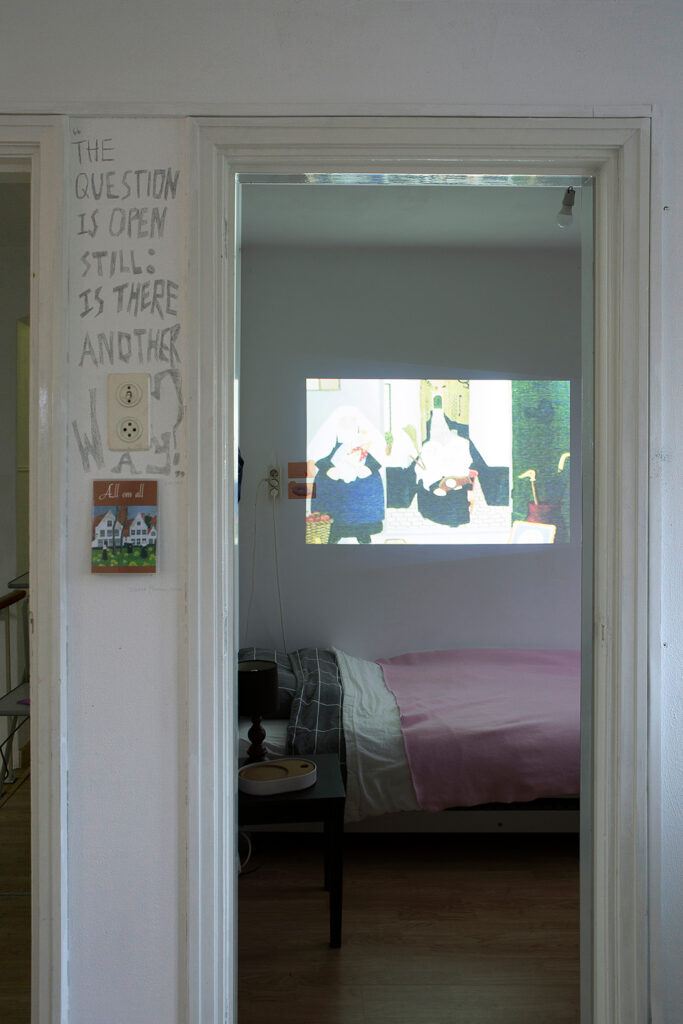 Agenda
Artikelen
Programma
Agenda
Artikelen
Programma

When I speak to her, Sun Chang has just moved her things from her residence at Witte Rook in Breda to her home in Amsterdam. Back home, but leaving behind another home in Breda. This is not surprising. As a visual artist, Sun does not so much work towards an end product like a sculpture of a painting, but investigates social fabrics and the different meanings we assign to social roles, in particular to motherhood. Her project to M•Others started in the lockdown winter of 2021 and was expanded and continued at Witte Rook. The residency in Breda was more than a working period, it was a chance to build a community.

Suns’ work at Witte Rook AIR | photo: Eline Baggen
After studying in Bejing and London, Sun studied at the Sandberg Institute in Amsterdam. Whilst at Sandberg, she mainly worked with foodstuffs, for example in the exhibition titled kənvìviaéləti, which included a dinner as well as a number of workshops. The main ingredient was soy, from miso to tempeh, from tofu to edamame the goal was to bring people together in the same place at the same time: a dialogue in a casual micro-society.
SC: Originally my work explored just that: How can I connect people? How can I work in a community? As a social artist I am interested in bringing different people together and researching how a shared sense of belonging can be created. As a visual artist my work should have an impact on the world and society in which I live. So I asked myself questions like: How do you make everyone a part of a group? I organized dinners as research, in which I connected my mission as an artist with the social aspects of food. Since 2020, the pandemic has made this virtually impossible. Additionally, the focus of my research shifted. Cooking is a part of one’s identity, as a person and as a woman. How do you, as a woman, relate to other domestic chores? As a feminist this is problematic, but I have started to explore what it does with me when I fully embrace the role of caretaker. What does this say about my identity, about my community, and about my work as a visual artist?
Sun’s residency at Witte Rook began in November 2021 and went on till January 2022. Somewhat unexpectedly, The Netherlands was in lockdown again. During her working period at Witte Rook, Sun developed a letter as a part of a long-term letter-writing project.
SC: The lockdown of spring 2020 was a personal lockdown for me. I was thrown back to myself, unable to travel for work or go home (BS: Sun Chang was born in Wuhan, China). My contacts also changed. This is why I started writing a letter, in collaboration with designer Léo Ravi. Letters have the great advantage that you can send them and get in touch, and that the letter can then be passed on. The lockdown demanded a new form of publishing. Everything was closed, even art institutions, bookstores, and museums. Getting in touch became very difficult. The household became even more the central point of my life. Besides the space for living, it became a place of work, as well as a place to meet people through a laptop or writings.

workprocesses by Sun and Vrouwenmantel during Witte Rook AIR | photo: Eline Baggen
Lockdown made another thing apparent: much of the work around the house is done by women. This is no news, but it made clear that even when everyone is at home, most chores still end up on the plates of women. Gender plays a role in the home. This was the starting point of my project to M•Others,in which I examine M(other)ing: mothering, taking care of another, the home, and oneself. I started examining motherhood as an action, not as a state of being. In the end motherhood, the act of mothering, is a sort of taking care of one another that can be performed by anyone, regardless of gender identity.
Sun is not a mother herself, nor does she have stepchildren. But her research into motherhood is not necessarily about giving birth, or the producing and rearing of offspring. Mothering is something we can do for each other: caring, looking after, to form a stronger, more consciously, bond, even with strangers.
Sun sets up the letters in a playful manner and offers a number of starting points for a conversation in the form of a game. Is reading aloud a type of work? Is it best to be comforted by your mother? The relationship between yourself and your role as a mother was broadened at Witte Rook. Can mothering be the starting point for setting up a network of, initially, women who help each other?
SC: The first letter, dated March 2021, was created in collaboration with several mothers, who, at my invitation, took part in the project in Amsterdam Zuidoost. Each of the women had a different relationship with motherhood: as grandmothers, housewives, single mothers, or stepmothers. Together we investigated what M(other)ing means in a context of an urban community with a large immigrant population. The resulting letter is available for pickup at a number of locations in Zuidoost.
Residencies at Witte Rook are set up as encounters. Three resident artists have their stay at the same time, one from the Breda region, one from The Netherlands, and one international guest. They live together in the Witte Rook buildings, and form a temporary community, together with the Witte Rook team. A number of them are mothers, and thus my project has found a deepening in the residency. Especially after meeting Kija Benfold, the co-author of the letter that will appear in early February. In this letter we examine the relationship between motherhood and being an artist, a theme that is also central in Kija’s work. How can you raise a child and create?
The letter How do you invite Mothering back into the Arts? Is more than just a result of research, it is a pamphlet, although Sun describes it as an invitation.
SC: In the conversations with Kija it soon became apparent that artistry and motherhood seem to be two separate identities within the art world.While there are so many commonalities. Skills, for example. As an artist you are trained in the development of artistic skills, like painting or calligraphy. As a mother you also have skills that you train consciously and unconsciously, such as caring, but also communicating, putting people at ease, and maintaining relationships.These are not only skills, they are a way of thinking that promotes cohesion.
In our letter we invite the art world to discuss their views on motherhood and artistry.
How can we raise children and create? But, more precisely, how can we create an art world that revolves around shared values such as caring for each other, rather than individual success?As a starting point, I interviewed a number of women, mothers, who operate within the Witte Rook community.Their insights and knowledge are part of the letter. We invite the art world to continue this polyphonic exchange.
100 letters will be printed and sent to museums and other art institutions, as an invitation to reflect on the art institute as a space for caring for each other and the community.
SC: In the end, everyone can be a mother, regardless of gender or sex. M(other)ing is a verb, an intention.